

Practical Ideas to Keep Workplace Relationships Satisfying. By Sylvia Haskvitz Workplace relationships are complex.
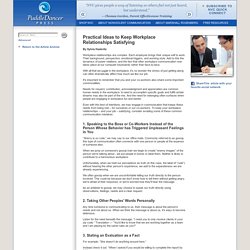
Each employee brings their unique self to work. Their background, perspective, emotional triggers, and working style. Add to this the dynamics of power relations, and the fact that often workplace communication now takes place at our computer keyboards rather than face-to-face. With all that we juggle in the workplace, it’s no wonder the stress of just getting along can often dramatically affect how much we like our job. It's important to remember that you and your co-workers also share some important commonalities. Needs for respect, contribution, acknowledgment and appreciation are common human needs in the workplace. Even with the best of intentions, we may engage in communication that keeps these needs from being met – for ourselves or our co-workers. 1.
“Sherry is so rude,” we may say to our office mate. We often gossip when we are uncomfortable telling our truth directly to the person involved. Proven Steps to Boost Meeting Productivity and Enjoyment. Proven Steps to Boost Meeting Productivity and Enjoyment By Rachelle Lamb If you’re like most people, you spend a lot of time engaged in meetings — whether for work, family, or as a volunteer.
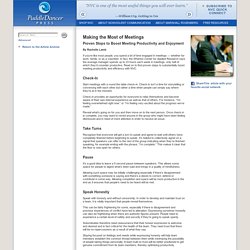
In fact, the Wharton Center for Applied Research says the average manager spends up to 23 hours each week in meetings, only half of which they’d consider productive. Read on to find proven steps to substantially boost meeting productivity and efficiency with NVC. Check-In Start meetings with a round the table check-in. Check-in provides an opportunity for everyone to relax themselves and become aware of their own internal experience as well as that of others. Reveal what’s going on for you and then move on to the next person. Take Turns Recognize that everyone will get a turn to speak and agree to wait until others have completely finished before beginning to speak. Pause It’s a good idea to leave a 5 second pause between speakers. Speak Honestly. NVC Concepts. Nonviolent Communication (NVC) is sometimes referred to as compassionate communication.
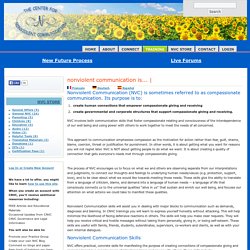
Its purpose is to: create human connections that empower compassionate giving and receivingcreate governmental and corporate structures that support compassionate giving and receiving. NVC involves both communication skills that foster compassionate relating and consciousness of the interdependence of our well being and using power with others to work together to meet the needs of all concerned. This approach to communication emphasizes compassion as the motivation for action rather than fear, guilt, shame, blame, coercion, threat or justification for punishment. In other words, it is about getting what you want for reasons you will not regret later. Foundations of Nonviolent Communication.
"The dynamic communication techniques of Nonviolent Communication transform potential conflicts into peaceful dialogues.
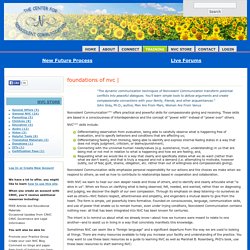
You'll learn simple tools to defuse arguments and create compassionate connections with your family, friends, and other acquaintances. "John Gray, Ph.D., author, Men Are From Mars, Women Are From Venus Nonviolent Communication(sm) offers practical and powerful skills for compassionate giving and receiving. These skills are based in a consciousness of interdependence and the concept of "power with" instead of "power over" others.
NVC(sm) skills include: The nvc model. Feelings Inventory. The following are words we use when we want to express a combination of emotional states and physical sensations.
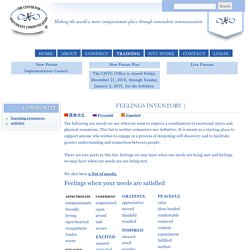
This list is neither exhaustive nor definitive. Needs Inventory. The following list of needs is neither exhaustive nor definitive.

It is meant as a starting place to support anyone who wishes to engage in a process of deepening self-discovery and to facilitate greater understanding and connection between people. We have another list that might also be of interest to you: a list of feelings. The contents of this page can be downloaded and copied by anyone so long as they credit CNVC as follows: (c) 2005 by Center for Nonviolent Communication Website: www.cnvc.org Email: cnvc@cnvc.org.
Group Decision Making: A Nonviolent Communication Perspective. By Ike Lasater With Julie Stiles We’ve all taken part in groups where decisions were made about what the group will do; perhaps a work team where project goals and tasks were to be decided upon, or a workshop context where different options existed to reach learning goals.
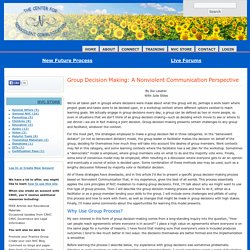
We actually engage in group decisions every day; a group can be defined as two or more people, so even in situations that we don’t think of as group decision-making—such as deciding which movie to see or where to eat dinner—we are in fact making a joint decision. Group decision-making presents certain challenges to any group and facilitator, whatever the context. For the most part, the strategies employed to make a group decision fall in three categories. In the “benevolent dictator” (or not so benevolent dictator) model, the group leader or facilitator makes the decision on behalf of the group, deciding for themselves how much they will take into account the desires of group members. Why Use Group Process? The Process. Key_facts_nvc. 4part_nvc_process.